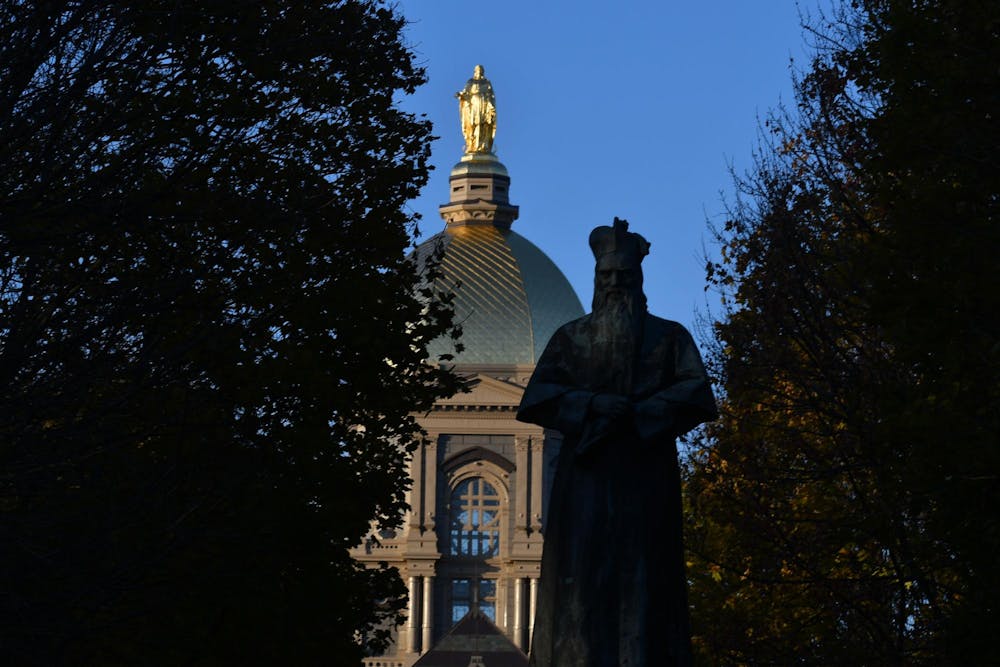“Camp,” a term used to describe a style of being, can’t be understood by many. In Susan Sontag’s seminal essay, “Notes on Camp,” she argues that sensibility is “something of a private code,” a way of seeing the world as an “aesthetic phenomenon,” loving the unnatural, the exaggeration, the artifice, the performance.
It is not something you can analyze — only something that you can exhibit. It loves irony, battling the “silly between rich form.” It is, essentially, to fail at being serious. Drag is a primary example: the gender subversion, the theatrics, the exaggeration of the natural. But camp appears in the mainstream too. Elvis exemplifies camp: the artifice of his rhinestone costumes, the mix of high and low culture in his music and the theatricality of his masculinity.
And, with the right eye, Notre Dame can be a prime example of camp, too. At the core of camp is theatrics — nothing “natural,” Sontag says, is camp. The spectacle of Notre Dame is one of its most camp features. Take the centrality of Touchdown Jesus in the Notre Dame ethos. The mural, which is an exaggerated depiction of Jesus with arms raised as a referee signaling a touchdown, projects Christ onto the culture of football. The rightfully prideful, but almost laughable, existence of the mural proves its campiness.
This depiction of Christ combines religious imagery with sports in a way that is both sincere and absurdly theatrical. Sontag describes this interplay in camp as “seeing everything in quotation marks.” So, is that figure “Jesus” or a “referee”? Unlike the prayers offered before the statue of Mary at the Grotto, we see Christ on the mural in a different context — when the Irish score a field goal. This mural elevates a religious icon into a realm where its significance becomes diluted by the culture of hypermasculinity and the commerciality of football. Rather than inviting a solemn or introspective engagement, it is a cultural icon, blurring the lines between reverence and silliness. The mural, essentially, is what Sontag calls a “failure to be serious.”
The aesthetics of camp can also be visually mapped onto the University’s architecture itself. The deliberate pastiche of European religious grandeur evokes a sense of maturity and sacredness, contrasting with the immaturity natural in college life. The Golden Dome, in and of itself, is emblematic of a camp aesthetic. It is a display of Catholic iconography that looms over the campus like a theatrical set. This architectural choice reflects not just a reverence for tradition, but a conscious performance of identity that invites scrutiny and interpretation. The inflated size and ‘gildedness’ of Mary herself is an unnatural depiction, much like the gaudy ‘gildedness’ of drag. Deliberate architectural excess makes Notre Dame not just a place of learning, but a stage where the sacred meets theatrics, a juxtaposition resulting in a camp aesthetic.
Theatrics, however, does not mean dramatics — camp embraces “things-being-what-they-are-not.” There exists a social commentary in the deeper meaning of camp: it takes what society honors and appreciates it for the irony of its contradictions. Notre Dame has plenty of contradictions that enable its campiness.
The performance of Notre Dame’s Catholic identity exemplifies camp. The University’s public displays of Catholic faith — mandatory theology courses, frequent campus masses and the exaggerated religious statuary on every quad — are infused with a sense of performative piety that borders on the theatrical. This self-conscious branding reflects a desire to craft an identity that resonates with both tradition and modernity, revealing the complexities of faith in a contemporary context.
The inauguration was a practice of this self-mythologizing that is central to camp. The rich, deep and over-the-top tradition was an inherent performance. But, that alone isn’t camp. Camp, which clearly can’t be described (or at least I can’t describe it), has to have something beyond mere theatrics: a contradiction, an excess, something that minimizes tradition, yet amplifies its beauty. The inauguration exemplifies this dynamic, as it presented a grand spectacle that simultaneously acknowledged and subverted the very traditions it sought to honor. “Gestures of Duplicity” are a hallmark of camp. Certainly, gestures to God and gestures to donors or commerciality are gestures of duplicity.
Camp, most importantly, allows us to view institutions like Notre Dame through a lens that questions the seriousness often associated with traditional narratives. As Sontag notes, camp “has the ability to transform experiences.” This transformation is not negative. By embracing the camp aesthetic, we can appreciate how Notre Dame’s elaborate displays of religion and theatrical traditions function as part of a larger performance, rather than solely as acts of piety. Understanding this performance invites a sense of irony and detachment, making it, frankly, easier to engage with religious displays and conservative culture. Rather than condemning Notre Dame for its perceived excesses or contradictions, camp encourages us to revel in its playful contradictions and theatricality.
To appreciate an institution like Notre Dame or the Catholic Church through a camp lens is to live within the artifice; inserting myself into the contradictions of Notre Dame allows me to become an actor in this campy performance of American conservative catholicism. It compels me to critically engage with the contradictions and excess of Notre Dame while reveling in the camp of it all. And what could be more camp than that?
Connor Marrott is a senior from Cleveland, Ohio His writing has appeared in the Cleveland Plain Dealer and the Cincinnati Enquirer. He serves on the board of SoildarityND and is always eager to discuss any and all ideas. You can contact Connor at cmarrott@nd.edu.










